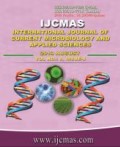


 National Academy of Agricultural Sciences (NAAS)
National Academy of Agricultural Sciences (NAAS)

|
PRINT ISSN : 2319-7692
Online ISSN : 2319-7706 Issues : 12 per year Publisher : Excellent Publishers Email : editorijcmas@gmail.com / submit@ijcmas.com Editor-in-chief: Dr.M.Prakash Index Copernicus ICV 2018: 95.39 NAAS RATING 2020: 5.38 |
In order to study the effects of repeated use of various insecticides on thrips and their natural enemies viz., Ladybird beetle and Predatory spiders, an experiment was conducted during Kharif, 2018-19at the Experimental farm, Department of Agricultural Entomology, Vasantrao Naik Marathwada Krishi Vidyapeeth, Parbhani. The insecticides selected included those used commonly among the farmers viz., Imidacloprid 17.8% SL, Fipronil 5% SC, Lambda cyhalothrin 5% EC, Spinosad 45% SC, Acephate 75% SP, Buprofezin 25% SC, Flonicamid 50% WG, Acetamiprid 20% SP, Profenofos 50% EC, Diafenthiuron 50%WP, Acephate 50% + Imidacloprid 1.8% SP, Pyriproxyfen 5% + Fenpropathrin 15% EC and Profenofos 40% + Cypermethrin 4% EC.From the first spraying onwards, Flonicamid 50% WG was found to be the best in reducing the thrips population steadily up to 0.50/leaf in second spraying. But, a sudden increase in population mean was found in the third (6.80/leaf) and fourth spraying (11.50). Same trend was followed in Fipronil 5% SC, Buprofezin 25% SC and Diafenthiuron 50% WP. The effect of repeated applications of synthetic insecticides on the natural enemies depicted that Spinosad 45% SC, Flonicamid 50% WG and Buprofezin 25% SC were the safest insecticides, showing maximum natural enemies population. Imidacloprid 17.8% SL, Fipronil 5% SC and Lambda cyhalothrin 5% EC recorded minimum natural enemies population marking its intense toxicity against them.
 |
 |
 |
 |
 |